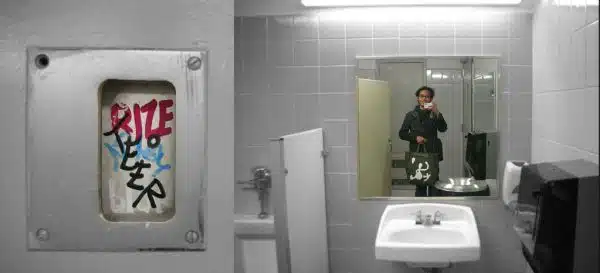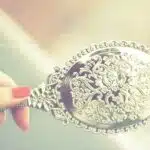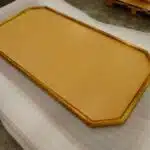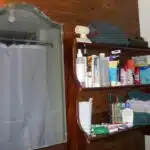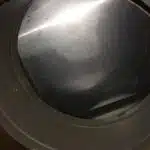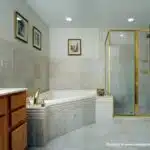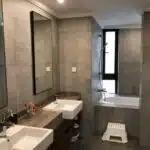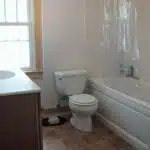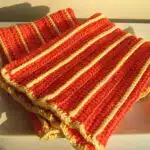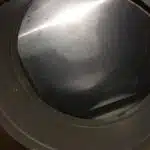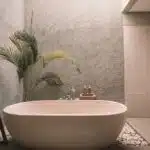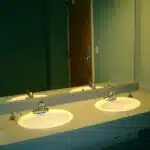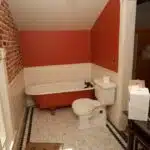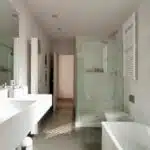Bathroom mirrors are an essential fixture in any home, providing a space for personal grooming and reflection. However, over time, bathroom mirrors may need to be removed for various reasons such as renovations or repairs. As a professional bathroom installation expert, I have encountered numerous situations where homeowners struggle with removing their bathroom mirrors without causing damage to the wall or mirror itself.
Removing a bathroom mirror may seem like a daunting task, but with the right tools and techniques, it can be done efficiently and safely. In this article, I will provide step-by-step instructions on how to remove a bathroom mirror without causing any damage to the surrounding area. Whether you are a homeowner looking to make some changes to your bathroom or a handyman looking for some helpful tips, this guide will equip you with the knowledge needed to successfully remove your bathroom mirror.
Assessing The Mirror’s Attachment
As a professional bathroom installation expert, I understand the importance of assessing the mirror’s attachment before attempting to remove it. This step is crucial in ensuring that you do not damage the wall or injure yourself during the process. Before starting, it is essential to check whether the mirror is compatible with your desired replacement. If it isn’t, then you may need professional assistance to ensure that you don’t create any further problems.
Once you’ve established compatibility, examine how the mirror is attached to the wall. Is it glued or screwed? If glued, use a razor blade to cut through the adhesive carefully. If screwed, locate and remove all screws holding the mirror in place. It’s important to note that some mirrors may have additional support brackets or clips that also need removal before proceeding.
Preparing the work area is vital before attempting to remove the mirror. By doing so, you’ll minimize potential damage and make cleanup more manageable afterward. Start by clearing out any items near and around the mirror, such as toiletries or decor. Cover surfaces with protective material like cardboard or drop cloths to prevent damage from falling glass shards during removal. With your work area prepared, proceed with caution to successfully remove your bathroom mirror without any issues or injuries.
Preparing The Work Area
After assessing the mirror’s attachment, it’s time to prepare the work area. Before you begin any work, ensure that you clear the clutter and remove any loose items from the bathroom. This is necessary to provide enough room for movement in case an accident occurs. Additionally, clearing clutter will prevent damage to any other fixtures within the bathroom.
It’s important to protect your bathroom fixtures before removing the mirror. You can do this by covering them with a drop cloth or old towels. This will prevent accidental scratches or chips that may occur during the removal process. It will also keep debris and dust from falling on these fixtures during the process.
By clearing clutter and protecting your fixtures, you have created a safe work environment for yourself while also preventing potential damage to your bathroom. Now that you’ve prepared the work area, you can move on to gathering the necessary tools for removing your bathroom mirror.
Gathering The Necessary Tools
In order to successfully remove a bathroom mirror, it is necessary to gather the appropriate tools. A screwdriver is essential to unscrew the mirror from its mount. Safety glasses and gloves should be worn during the process to ensure safety. A utility knife, putty knife, drill, drill bits, level, tape measure, screws, wall anchors, pliers, towel, plastic sheeting and bucket are also necessary for the task.
Screwdriver
When it comes to removing a bathroom mirror, having the right tools is essential. One of these tools is the screwdriver, which comes in different types that cater to various needs. The most common types of screwdrivers are flathead and Phillips head screwdrivers. A flathead screwdriver has a single blade that fits into the slot on the screw, while a Phillips head screwdriver has a cross-shaped end that fits into the corresponding cross-shaped slot on the screw.
Choosing the right type of screwdriver can make all the difference when removing a bathroom mirror. Before selecting one, it’s crucial to identify what kind of screws hold your mirror in place. If you have flathead screws, then you’ll need a flathead screwdriver; if you have Phillips head screws, then you’ll need a Phillips head screwdriver. Using the wrong type of driver can damage your screws and make them difficult to remove.
When buying a new set of screwdrivers, consider investing in high-quality ones that will last longer and perform better than cheaper alternatives. Choose drivers with comfortable handles that provide sufficient grip for easy handling during use. Additionally, ensure that they come in various sizes so that you have options for different jobs around your home. With these tips in mind, selecting the right type of screwdriver will help you remove your bathroom mirror efficiently without causing any damage or unnecessary complications.
Safety Glasses
Choosing appropriate tools is essential when removing a bathroom mirror, but it’s equally important to prioritize safety during the process. One of the most overlooked safety precautions is wearing protective eyewear such as safety glasses. Many people assume that their regular glasses or even contact lenses will suffice, but these are not designed to prevent flying debris and shattered glass from causing injuries.
When gathering the necessary tools for removing a bathroom mirror, it’s crucial to include affordable safety glasses in your checklist. These glasses are widely available at hardware stores and online retailers, and they come in different styles and sizes to fit various face shapes and preferences. Some have clear lenses for maximum visibility, while others have tinted lenses for added protection against glare and UV rays.
By choosing appropriate safety glasses before removing your bathroom mirror, you can prevent injuries that may result from broken glass or other debris. It only takes a split second for an accident to happen, so don’t take any chances with your eyesight. Investing in affordable safety glasses is a small price to pay for peace of mind knowing that you’re taking the necessary precautions to protect yourself during this DIY project.
Wearing Protective Gear
As a professional bathroom installation expert, I often compare the process of removing a bathroom mirror to that of performing surgery. Just as a surgeon wears protective gear to prevent contamination and injury during an operation, it is essential to wear appropriate gear when removing your bathroom mirror. The importance of safety cannot be overstated, as even a small mistake can result in injuries that could have been easily avoided.
When selecting appropriate gear for removing your bathroom mirror, there are several things to consider. First, make sure you have eye protection such as safety glasses or goggles to prevent any shards or debris from getting into your eyes. Second, wear thick gloves to protect your hands from cuts or scratches caused by broken glass or sharp edges on the mirror’s frame. Finally, consider wearing a face mask or respirator to avoid inhaling dust and debris that may be released during the removal process.
In addition to protecting yourself from potential hazards while removing your bathroom mirror, it is also important to take necessary precautions beforehand. Remove any loose items from the area surrounding the mirror and ensure that children and pets are kept away during the removal process. By taking these steps and wearing appropriate protective gear, you can ensure a safe and successful removal experience. Now that we know how vital protective gear is let’s move on to the next step – removing the mirror’s frame without causing any damage.
Removing The Mirror’s Frame
Once you have removed the mirror from its wall mount, the next step is to take off its frame. Before starting, make sure you have all the necessary tools such as a screwdriver and pliers. Begin by inspecting the frame for any screws that may be holding it in place. If there are any, remove them using a screwdriver.
If your mirror is frameless or you prefer not to reinstall the frame, you can skip this step altogether. However, if you do want to reinstall the frame, there are various options available to you. One option is to use adhesive strips specifically designed for frames. These strips provide a secure hold without damaging the mirror or wall. Another option is to use brackets that attach directly onto the mirror’s backside.
Mirror removal tips:
- Wear protective gloves and eye goggles during this process.
- Have a helper present to assist with larger mirrors.
- Clean up any broken glass immediately and dispose of it properly.
Frameless mirror options:
- Tilted mirrors: These types of mirrors are installed at an angle against the wall and don’t require frames.
- Beveled mirrors: The edges of these mirrors are cut at an angle which gives them a framed look without actually having a physical frame.
- Adhesive mounts: Similar to adhesive strips mentioned earlier for frames, these mounts attach directly onto the backside of your mirror and allow for easy installation onto your bathroom wall.
Now that we’ve covered removing the frame from your mirror, let’s move on to cutting through any adhesive that may be holding it in place.
Cutting The Adhesive
Removing a bathroom mirror can be a daunting task, especially when it’s attached with strong adhesive. Cutting the adhesive is one of the most effective ways to remove a bathroom mirror. However, it requires some precautions and knowledge to avoid damaging the wall or injuring yourself. Before proceeding with cutting the adhesive, it’s essential to take some measures.
Using heat is an effective technique for softening the adhesive before cutting. Applying a hairdryer or heat gun on low heat can help loosen the glue and make it easier to cut. It’s crucial to avoid overheating the mirror as this could cause cracks or breakage. Additionally, alternative methods for removing adhesive from a bathroom mirror include using vinegar or rubbing alcohol. These substances are effective in breaking down adhesives without causing any harm to the wall.
While cutting through the adhesive, it’s important to take precautionary measures such as wearing gloves and safety goggles. The gloves protect your hands from cuts while handling sharp objects such as razor blades, which are commonly used for cutting adhesive. Safety goggles protect your eyes from debris that may fly off during the process. Always ensure you have proper ventilation in the room to avoid inhaling toxic fumes produced by some adhesives.
Transitioning into loosening the mirror section: With all these precautions taken care of, you’re now ready to start cutting through the adhesive holding your bathroom mirror in place. Once you’ve cut through all sides of the mirror, it should come off easily without any damage or injury.
Loosening The Mirror
After cutting the adhesive, the next step is to loosen the mirror from the wall. This process involves separating the mirror from the brackets that hold it in place. To do this, you can use a heat gun to soften the adhesive and make it easier to remove.
Using a heat gun is an effective way to loosen the adhesive without damaging the mirror or wall. Simply aim the heat gun at one corner of the mirror and apply heat for several minutes until the adhesive softens. Then, use a putty knife or scraper to gently pry up one corner of the mirror.
If you are uncomfortable using a heat gun or are unsure about how to proceed with removing your bathroom mirror, consider hiring a handyman for assistance. A professional handyman can safely and efficiently remove your mirror, ensuring that no damage is done to your walls or surrounding fixtures. With their expertise and experience, they can guide you through each step of removing your bathroom mirror and provide additional support as needed.
When supporting the weight of your bathroom mirror during removal, it is important to take precautions to prevent any accidents or injuries. One option is to have someone hold onto one side of the mirror while you work on removing it from its brackets on the other side. Alternatively, you can use suction cups or straps to secure and support the weight of the mirror as you work on loosening it from its brackets. By taking these steps, you can safely remove your bathroom mirror without risking damage or injury.
Supporting The Mirror’s Weight
Before removing a bathroom mirror, it is important to ensure that it is properly supported to prevent it from falling and causing damage or injury. To do this, you can use leverage to create tension against the bottom of the mirror while securing it in place.
One way to support the mirror’s weight is by propping a 2×4 piece of lumber against the bottom edge of the mirror. This will help distribute its weight evenly and provide extra stability. Alternatively, you can use wooden shims inserted between the wall and back of the mirror to keep it from moving around.
Another method for supporting a heavy bathroom mirror involves using suction cups with handles. These tools create a vacuum seal against the glass surface, providing secure gripping points for lifting and carrying. If you don’t have suction cups available, you may also use duct tape or packing tape to create handles on either side of the mirror.
By taking these steps to properly support your bathroom mirror, you can avoid potential accidents and ensure that it comes off safely when you are ready to remove it from the wall.
Next: Removing The Mirror From The Wall
Removing The Mirror From The Wall
To remove a bathroom mirror from the wall, you will need to gather a few tools and follow a set of steps to ensure that the process is carried out correctly. The first step is to prepare your work area by clearing the space around the mirror and covering any fixtures or surfaces with a protective layer. Next, use masking tape to create an outline of the mirror on the wall, which will help guide your removal process and prevent damage to surrounding areas.
Once you have prepared your work area, you can proceed with removing the mirror from the wall. Start by locating any screws or brackets holding it in place and using a screwdriver or wrench to loosen them. If there are no visible screws or brackets, then you may need to pry the mirror away from the wall using a putty knife or scraper. Be sure to wear gloves during this process to avoid injury.
After successfully removing the mirror from the wall, you can now decide whether to replace it with another mirror or explore alternative options for bathroom decor. Mirror replacement is often straightforward if you are replacing it with one of similar size and style. However, if you are looking for something different, then consider exploring alternatives such as decorative tiles or artwork that can enhance your bathroom’s aesthetic appeal while also serving a functional purpose.
Moving forward, cleaning both the mirror and wall surface is crucial before installing anything new. In the next section, we will discuss how to properly clean these surfaces without causing any damage.
Cleaning The Mirror And Wall Surface
After successfully removing the bathroom mirror, it is important to thoroughly clean both the mirror and the wall surface. Mirror cleaning techniques vary depending on the type of mirror, but a basic approach involves using warm soapy water and a microfiber cloth. Avoid using abrasive cleaners or materials that may scratch or damage the mirror’s surface.
Once the mirror is cleaned, it’s time to prepare the wall surface for any repairs or replacement. This involves removing any adhesive residue left behind by the old mirror. A plastic scraper can be used to gently scrape off any excess adhesive, being careful not to damage the wall surface. After scraping off as much residue as possible, wipe down the area with a clean cloth and a mild cleaning solution.
Before moving on to patching holes in the wall, it’s important to ensure that the wall surface is completely dry and free from debris. Use a damp cloth to remove any remaining dust or dirt, then allow sufficient time for the area to dry completely before proceeding with repairs. Taking these steps will help ensure a smooth and successful mirror removal process without causing damage to your bathroom walls.
Transition: With your bathroom mirror removed and your wall surfaces cleaned and prepared, you are now ready for patching holes in your walls.
Patching Holes In The Wall
After removing a bathroom mirror, it’s important to address any damage or holes that may have been left behind on the wall. Wall repair is necessary to ensure a smooth and even surface for any future treatments or decor options. To begin the process of wall repair, first remove any remaining adhesive from the mirror backing and clean the area with soap and water.
One option for patching holes in the wall is to use spackling compound. This material can be applied with a putty knife and smoothed over the hole until it’s level with the surrounding wall. Allow the spackling to dry completely before sanding it down lightly and applying a coat of primer. Another alternative is self-adhesive mesh tape, which can be applied over larger holes or cracks before being covered with joint compound. This method provides added strength to the repaired area and ensures that it won’t crack or break again in the future.
Once the repairs have been made, consider alternative decor options for your bathroom. While mirrors are a popular choice for a reason, there are other ways to add depth and interest to your space. Consider adding shelves or artwork to create focal points on your walls. If you do choose to replace your mirror, there are many different styles and shapes available on the market today that can add an updated look to your bathroom without breaking the bank. Alternatively, you could explore other wall treatments such as wallpaper or tile accents to bring new life into your space.
Replacing The Mirror Or Wall Treatments
Once you have successfully removed your bathroom mirror, it’s time to consider either installing a new mirror or updating the wall treatments. If you opt for a new mirror, consider the size and style that would best fit your bathroom’s overall aesthetic. Additionally, take measurements of the space to ensure that the new mirror fits perfectly.
If you want to add a personal touch to your new mirror, try DIYing a custom frame. There are plenty of tutorials online that can guide you through this process using materials such as wood, tile, or even seashells. Alternatively, if you prefer to keep it simple, there are pre-made frames available in various styles and colors that can be easily attached to your new mirror.
If you decide against a new mirror but still want to update the look of your bathroom, consider adding some decorative elements to the walls. You could hang artwork, install shelving for storage and display purposes, or experiment with wallpaper or tile patterns. The possibilities are endless when it comes to decorating ideas for your bathroom walls!
Moving forward into our next section about troubleshooting common issues during this process…
Troubleshooting Common Issues
After successfully replacing the mirror or wall treatments, unexpected damage may occur during removal. This can range from minor cracks in the wall to major structural damage. It is important to assess the extent of the damage and take appropriate action before proceeding with any further installations. In some cases, it may be necessary to call in a professional.
Another important consideration when removing a bathroom mirror is safety. Mirrors can be heavy and fragile, so precautions should be taken to avoid injury. Make sure to wear gloves and protective eyewear, and use caution when handling the mirror. It is also important to ensure that the area around the mirror is clear of any obstacles or tripping hazards.
For those who are interested in DIY removal of their bathroom mirrors, there are several tips to keep in mind. First, make sure to gather all necessary tools and materials beforehand, including a putty knife, adhesive remover, and protective gear. Next, carefully pry the mirror away from the wall using a putty knife or other flat tool. Finally, use adhesive remover to clean residual glue from both the mirror and wall surfaces.
Moving forward with these considerations will ensure safe and successful removal of your bathroom mirror while avoiding unnecessary damage or injury.
Tips For Diy Removal
- Before attempting to remove a bathroom mirror, it is important to first gather the necessary supplies, such as a screwdriver, a pry bar, safety glasses, and a towel.
- The mirror should be prepared for removal by taping the edges with a wide strip of masking tape to limit the risk of shattering.
- Care must be taken to avoid damaging the wall by gently prying the mirror away from the wall while wearing safety glasses.
- Removing all of the hardware, including screws and wall anchors, is essential to ensure a successful removal process.
- A large tarp or towel should be placed on the floor or bathtub to protect the mirror from shattering while it is being removed.
- Once the mirror is completely removed from the wall, it should be handled with care and placed in a safe location until it is ready to be reinstalled.
Gather Supplies
Securing your workspace and preparing yourself with protective clothing is a crucial first step when it comes to removing a bathroom mirror. To begin, make sure that you have ample space to work around the mirror without any potential obstructions or hazards. This will prevent any unnecessary accidents or injuries while you are working. Additionally, ensure that the area is well lit and that you have all the necessary tools close at hand.
When it comes to protective clothing, it’s important to wear gloves and eye protection at all times during the removal process. Gloves will protect your hands from any broken glass, while eye protection will keep your eyes safe from any debris that may fly up as you remove the mirror. Remember to always take precautions when handling glass, as it can be extremely dangerous if not handled properly.
In addition to securing your workspace and wearing protective clothing, there are a few other supplies you’ll need for removing a bathroom mirror. These include a putty knife or scraper for removing adhesive, a pry bar for gently prying the mirror away from the wall, and a drop cloth or tarp to catch any falling debris. With these supplies on hand and by taking the appropriate safety measures, you’ll be well-prepared for successfully removing your bathroom mirror without incident or injury.
Prepare The Mirror
Removing a bathroom mirror can be a daunting task, but with the right tools and precautions, it can be done safely and efficiently. As a professional bathroom installation expert, I recommend that you prepare the mirror properly before removing it from the wall. This will not only make the process easier but will also prevent any damage to the mirror or surrounding area.
The first step in preparing the mirror is to remove any hardware that may be holding it in place. This includes any screws, brackets or clips that are securing the mirror to the wall. Use a screwdriver or pliers to carefully remove these items without causing any damage to the wall or mirror. Be sure to keep them in a safe place for later use.
Once you have removed all of the hardware, take precautions when handling the mirror itself. Mirrors are fragile and can easily break if mishandled. To avoid this, wear gloves and protective eyewear at all times when handling your bathroom mirror. Carefully lift and remove the mirror from its position on the wall, taking care not to drop or twist it as you go. By following these steps, you’ll be well on your way to successfully removing your bathroom mirror!
Remove Carefully
As a professional bathroom installation expert, it’s important to always prioritize safety when removing a bathroom mirror. One key tip to keep in mind is to remove the mirror carefully. This involves taking every precaution possible to avoid accidents or damage during the removal process.
To do this, begin by securing the area around the mirror. Clear out any furniture or items that may be in the way and lay down protective covering on the floor. It’s also important to wear gloves and eye protection when handling mirrors, as they can easily break if mishandled.
When you’re ready to remove the mirror, take it slow and steady. Use a pry bar or putty knife to gently loosen any adhesive holding it in place. As you lift the mirror off of the wall, make sure to keep it level and avoid twisting or bending it too much. With these tips and tricks in mind, you’ll be able to safely and efficiently remove your bathroom mirror without any accidents or damage along the way.
Hiring A Professional For Assistance
When it comes to removing a bathroom mirror, the task may seem straightforward at first glance. However, there are several factors to consider before attempting the removal process on your own. One option is to hire a professional for assistance.
Pros and Cons of Hiring a Professional
One advantage of hiring a professional is that they have the necessary tools and experience to remove the mirror safely and efficiently. They can also assess any potential risks or complications that may arise during the removal process. On the other hand, the cost of hiring a professional may be higher than doing it yourself. Additionally, scheduling an appointment with a professional may not always align with your timeline.
Cost Comparison
The cost of hiring a professional for mirror removal will vary depending on several factors such as location, size of the mirror, and level of expertise required for removal. It’s important to do research and compare prices from different professionals in your area before making a decision. While hiring a professional may come with added costs, it can ultimately save you time and prevent potential damage to your bathroom walls or flooring.
By considering both the pros and cons of hiring a professional for assistance with mirror removal, you can make an informed decision that aligns with your specific needs and budget. Whether you decide to tackle the job yourself or bring in outside help, it’s important to prioritize safety and take necessary precautions when removing any bathroom fixture.
Conclusion
When it comes to removing a bathroom mirror, there are several steps that need to be taken to ensure the process is safe and successful. It is important to carefully assess the mirror’s attachment and prepare the work area before gathering the necessary tools and wearing protective gear. Removing the mirror’s frame can then be done methodically, either by prying it off or using a wire or string.
Once the mirror has been removed, homeowners may choose to replace it with a new one or consider wall treatments such as wallpaper or tiles. However, it is important to troubleshoot any common issues that may arise during removal, such as stubborn adhesive residue or difficulty in prying off the frame. For those who are not confident in their DIY skills, hiring a professional for assistance may be the best option.
In summary, removing a bathroom mirror requires careful planning and attention to detail. By following these steps and taking appropriate precautions, homeowners can successfully remove their mirrors without damaging surrounding surfaces or injuring themselves. Whether opting for a DIY approach or seeking professional help, homeowners should prioritize safety and thoroughness throughout the process.
Image Credits
- “Bathroom Mirror” by moriza (featured)

